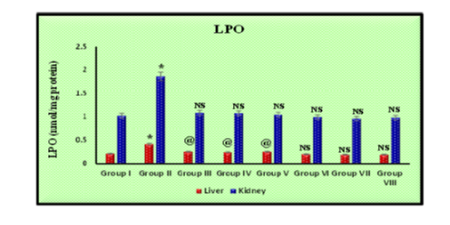


Indian Journal of Science and Technology
DOI: 10.17485/IJST/v14i36.1688
Year: 2021, Volume: 14, Issue: 36, Pages: 2815-2825
Original Article
Gangadharan Malathi1, Jayavelu Vadivelu2*, Shanmugam Rajeshkumar3
1Research Scholar, Post Graduate and Research Department of Biochemistry, Sri Akilandeswari Women’s College, Wandiwash, 604408, Tamil Nadu, India
2Assistant Professor, Post Graduate and Research Department of Biochemistry, Sri Akilandeswari Women’s College, Wandiwash, 604408, Tamil Nadu, India
3Nanobiomedicine lab, Department of Pharmacology, Saveetha Dental College and Hospitals, Saveetha University, SIMATS, Chennai, 600077, TN, India
*Corresponding Author
Email: [email protected]
Received Date:10 September 2021, Accepted Date:11 October 2021, Published Date:03 November 2021
Objective: To assess the natural bio-remediation in Hexavalent chromium (Cr VI) toxicity induced rats. Methodology: Male albino rats were given Hexavalent chromium for 42 days to demonstrate that this carcinogenic compund increased LPO while reducing SOD, GSH, GPx, and CAT levels. Rats were randomly divided into five experimental groups (n=6). Group I was a control group as they were only given with clean water to drink. Potassium dichromate 10 g/kg was given to Group II for 42 days. Group III administered with 500 mg/kg of Cucumis melo L, Group IV was administered with 500 mg/kg of Ascorbic acid and Group V was administered with 1:1 ratio of Cucumis melo L and ascorbic acid, respectively. All results were provided as mean SD for a total of 6 rats/ per each group. The significance of differences between male albino rats was determined using the Student’s t-test. At p < 0.05 and p < 0.001, differences were judged significant. Findings: Cucumis melo L. fruit aqueous extracts significantly protected rats from chromiuminduced oxidative damage. The LD50 was determined to be 500 mg/kg using the DPPH assay. As a consequence, we believe that giving fruit extracts to people can help them recover from oxidative stress-related cell damage.
Novelty: The administration of chromium 6 resulted in a substantial reduction in body weight and an increase in the organ to body weight ratio. Chromium administration significantly enhanced LPO while decreasing serum levels of SOD, GSH, GPx, and CAT. Cucumis melo aqueous fruit extract was shown to be a protective agent against chromium-induced oxidative stress at a dosage of 500 mg/kg.
Keywords: Chromium VI; Cucumis melo L fruit extracts; antioxidant activity; oxidant antioxidant imbalance and oxidative stress
© 2021 Malathi et al. This is an open-access article distributed under the terms of the Creative Commons Attribution License, which permits unrestricted use, distribution, and reproduction in any medium, provided the original author and source are credited. Published By Indian Society for Education and Environment (iSee)
Subscribe now for latest articles and news.